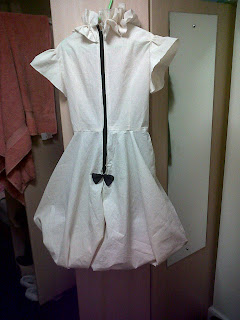This project required us to translate our 2D designs into 3D toiles. We had to design a properly tailored dress, draw up and make our own patterns and then use these to sew together a basic toile of the dress in calico.
I found this project to be extremely beneficial in teaching me essential skills which will be undoubtedly useful throughout my future work. I was able to explore the processes required for proper garment construction and it really interesting to learn the correct way to create pieces from initial sketches right through to the final outcome. I realised that there is alot more to consider when designing than perhaps I initially thought. Previously, I believed that designing was the more straightforward part of the process and that garment construction was more time consuming and complicated. However, this project demonstrated to me quite the opposite. I discovered that it is very easy to sketch out attractive designs but when it comes to the practicality of making them, some things are not always possible because there are a number of things which must be considered. It became apparent that construction and pattern-making must be a running thread involved throughout the design procedure.
Once I had decided on my final design, it was really fascinating to find out how to manipulate block patterns to create ones specific to your own designs. The importance of total accuracy became clear very quickly and despite being a lengthy process I found that it is worth spending time over to ensure the garment will fit correctly in the final piece. I would say that despite the fact I did spend most of my time designing and pattern-making, if I had the chance to go back and re-do this project I would take even more time over these processes. I think I was conscious of the fact that I had a whole dress to sew together, which seemed a bit overwhelming at the time, and so I didn’t take as much time as I could have when it came to creating the master draft. This meant that I had to re-do parts of it a couple of times, but I am glad that my tutors assisted me in realising these potential problems whilst I was still drafting, rather than once I had already begun construction, because I found that putting the garment together is possibly the easiest part of the whole process, provided that care and attention was taken over drafting and pattern-making.
Overall, I think the project went fairly well and I did learn alot about design realisation. However, I did feel that creativity can seem quite restricted when trying to design something that you can make using traditional pattern-cutting techniques when you only know the basics. So far I have found that working on the stand allows me to have more creative freedom, but I would love to learn more about pattern-cutting nonetheless. I would also like to explore moulage further in depth as this could combine the freedom of working on the stand with creating properly constructed patterns and I intend on building upon the skills I have learned during this project through experimentation within private study.
Once I had decided on my final design, it was really fascinating to find out how to manipulate block patterns to create ones specific to your own designs. The importance of total accuracy became clear very quickly and despite being a lengthy process I found that it is worth spending time over to ensure the garment will fit correctly in the final piece. I would say that despite the fact I did spend most of my time designing and pattern-making, if I had the chance to go back and re-do this project I would take even more time over these processes. I think I was conscious of the fact that I had a whole dress to sew together, which seemed a bit overwhelming at the time, and so I didn’t take as much time as I could have when it came to creating the master draft. This meant that I had to re-do parts of it a couple of times, but I am glad that my tutors assisted me in realising these potential problems whilst I was still drafting, rather than once I had already begun construction, because I found that putting the garment together is possibly the easiest part of the whole process, provided that care and attention was taken over drafting and pattern-making.
Overall, I think the project went fairly well and I did learn alot about design realisation. However, I did feel that creativity can seem quite restricted when trying to design something that you can make using traditional pattern-cutting techniques when you only know the basics. So far I have found that working on the stand allows me to have more creative freedom, but I would love to learn more about pattern-cutting nonetheless. I would also like to explore moulage further in depth as this could combine the freedom of working on the stand with creating properly constructed patterns and I intend on building upon the skills I have learned during this project through experimentation within private study.
Here are some photos of my calico dress with ruffled collar, puffball skirt and cute bow.



No comments:
Post a Comment